



RISC OS 6 Part 2
The final part of our two part series looking at RISC OS 6

The RISCOS 6 title banner
Last time I ended up saying that on this part we would take a closer look at what has actually changed in RISC OS 6. There is a lot so we will start with the application suite.
Applications
Although it has no impact on users of 26bit machines you may be interested to know that the entire RISC OS 6 application suite is 32bit neutral. As such it can be run on the A9 computer from Advantage Six. Indeed all the disc based components, including the entire !Boot sequence, are now capable of running on 32bit hardware. Although this has little impact for now it shows that RISCOS Ltd are committed to producing full 32bit versions of RISC OS 6 in the near future.
Moving through the applications themselves a lot of work has been done. Lets start with Paint and Draw.
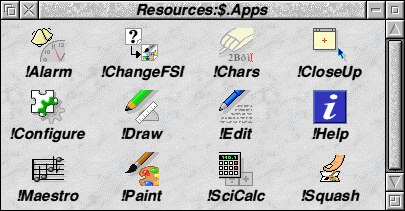
RISC OS 6 Apps
Draw has had yet another overhaul and maintains the style of menu structure that was introduced with RISC OS Select. One of the main changes with RISC OS 6 is the introduction of a standard method for altering an applications settings. All components now have a standard "Choices" entry on their iconbar menus, and Draw is no exception. All the complex "settings" that could only be applied using a third party program, such as DrawWorks, can now be set from !Draw itself.
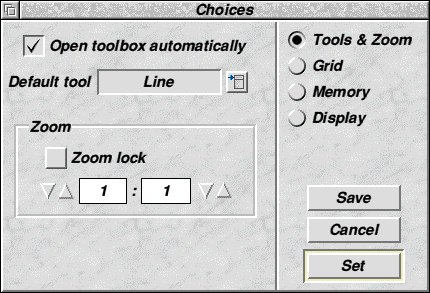
Draw Config Window
Draw now also benefits from the RISC OS 6 "Image File Renderer". This component is designed to allow any application to be able to load all sorts of files without having to understand how the file works. This means that Draw (and Paint as well as others) can load lots of different format files including PNG, GIF, TIFF etc. If extra "importers" are added to the image file renderer then any application that uses this will then be able to automatically load this file type, without any further software engineering.
As well as being able to import extra file types Draw can also save in PostScript and SVG formats. One of the other interesting changes to Draw is the support for hardware acceleration in the rendering of drawfiles. This means that Draw can render objects quicker. Indeed even a standard StrongARM RiscPC seems to be noticeably quicker when running RISC OS 6. Machines fitted with hardware that supports true acceleration, such as the A9 and ViewFinder equipped RiscPCs can benefit even more.
Moving on to Paint, this also uses the image file renderer to allow it to import and display all sorts of bitmap files. This is a very worthwhile improvement on its own but there are more. The "screenshot" feature has been greatly improved and can now just grab a single window, rather then the entire desktop. In common with all new RISC OS 6 applications paint can also have it's choice set from the iconbar menu.
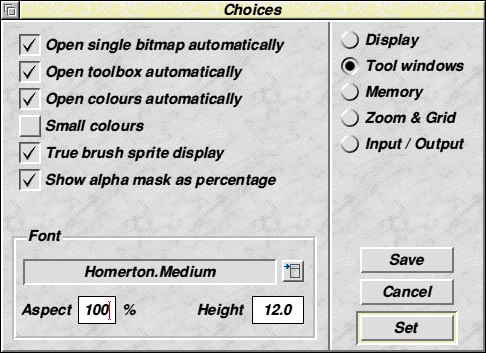
Paint Config Window
As well as updated versions of Draw and Paint some other applications have made a welcome return. The on-screen magnifier, CloseUp, has now re-appeared (it was last seen with RISC OS 4.02). There is a new version of Meteors that takes advantage of hardware acceleration, Maestro has been fully 32 bitted and many others have been improved in various ways. There is also a much improved version of Chars with proper support for Base 0 fonts. This allows you to display characters from a different language to the currently selected set. For example you can display Polish accented letters, whilst still running the machine with Latin 1 (West Europe) settings.
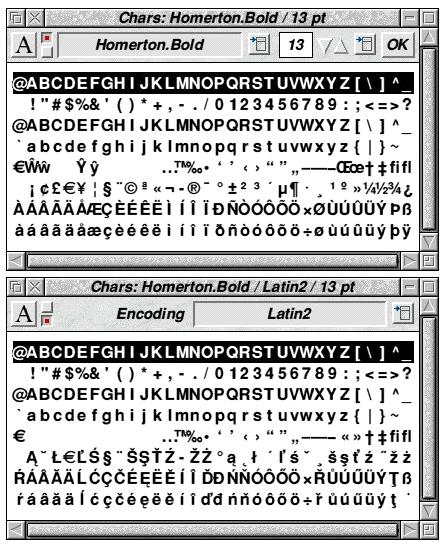
Chars showing both Latin1 and lLatin 2 character sets
This ethos seems to have been extended throughout the application suite. Everything has been improved, although none of the changes are earth shattering they are all useful and extend the features of RISC OS. Several times I've been thinking "I wish sos and so would do this..." only to discover that on RISC OS 6 it does.
Video
RISC OS 6 is the first version of RISC OS to directly support a Viewfinder without patches. Currently Rage128 based cars are supported (which is most ViewFinders) with support for the other versions following at some point. When using a ViewFinder RISC OS can take advantage of the hardware acceleration to speed up the desktop. It's worth pointing out that even without a ViewFinder a standard RiscPC seems to run the video system more efficiently.
As an example one of the RISCWorld machines is running 1600x1200 on a standard VIDC. With RISC OS 4 this is a bit marginal and on hot days the machine suffers from display shimmer as the VIDC is being overdriven. After installing RISC OS 6 the problem went away. Indeed it was possible to squeeze an extra few Mhz out of the screen display before the shimmer returned. Some brief tests that I have done in the desktop seem to show that almost everything is slightly faster with RISC OS 6. One of my particular bugbears with all versions of RISC OS has now been addressed, that's slow opening of long menus. My calculations showed the speed improvement in this area was several thousand percent!
The video system is now abstracted, so support for accelerated video on the A9 and on other platform can be added at a due date. Another nice facility is the "Try" button on the mode selector. If you click this the new mode will be selected, but unless you confirm the mode change it will flick bask after a few seconds. This prevents you ending up with a black screen if you select a mode your monitor can't handle.
In addition you can now select a different screen mode for Viewfinder and VIDC connections, as well as make other "tweaks" to the video system.
Documentation
RISCOS Ltd documentation was never very good, indeed non-existent would be a good word. As I said in my previous article one of the aims with RISC OS 6 was to get this sorted out. RISC OS 6 comes with a very comprehensive HTML user guide that covers all the major (and some minor) applications. it also covers the new configure system in a lot of detail. Also included is the RISC OS 6 PRM (Programmers Reference Manual). It;s well worth reading through this as it contains a lot of information. I was involved in writing some of the documents and even I found out things I didn't know and I've been using RISC OS for 18 years.
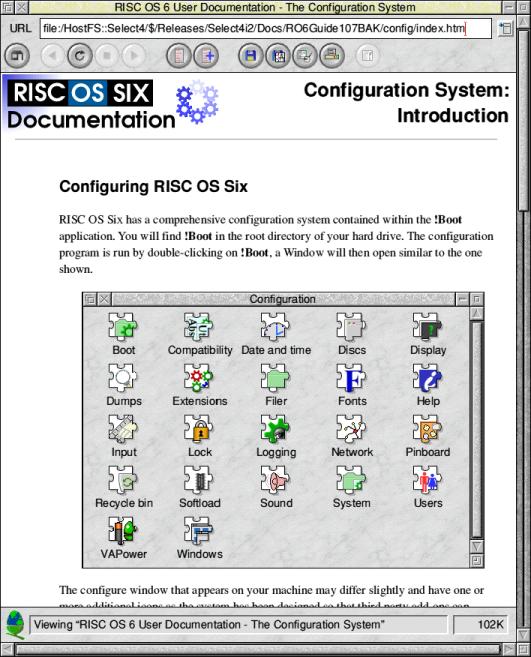
The configuration part of the RISC OS 6 user guide
Under the Skin
There have been a lot of improvements under the skin with RISC OS 6. You only have to look at the version number changes in many of the modules to see that a lot of work has gone on. Everything seems to have been tweaked. Given that it's been 3 years since the previous release of RISC OS 4.39 this isn't a great surprise. There are some nice little features that you might not even see.
For example if you install RISC OS 6 on a machine and on the first boot some errors occur then an automatic reporting system will start. You will see the error messages then once the desktop has started a window will open containing a full report of what has happened, so you can fix the problems. If you have a problem with your boot drive and your boot sequence doesn't get run correctly then you will get a different start up banner with a warning message.
There is a lot more. RISC OS 6 is much more stable than earlier versions and can protect the OS from badly behaved applications. New configure tools allow you to set the level of compatibility/stability easily so you can make sure that older programs will run without problems, or to stop anything that's badly behaved from starting up.
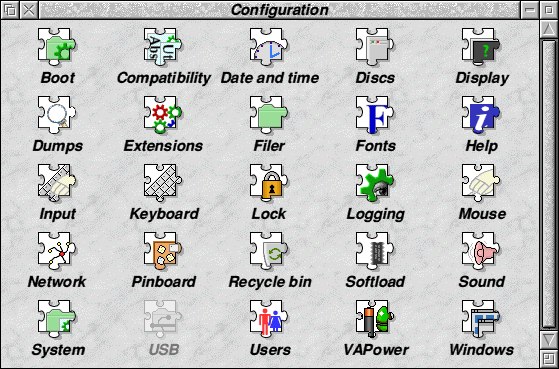
RISC OS 6 configuration
I've only scratched the surface of what's new in RISC OS 6. The user guide runs to hundreds of pages and even that doesn't cover absolutely everything. The more I use it the more little changes and improvements I find.
Overall
I like RISC OS 6, I really do. In my opinion it's the best version of RISC OS yet. For those that use RISC OS on a daily basis (and have a RiscPC/A7000.VirtualRPC) it's a very worthwhile upgrade. I can't say it's totally essential, but once you've had it you won't want to go back to an earlier version of RISC OS. There are bound to be a few things that don't quite work as expected, but that's what happens at the bleeding edge of OS development. It's also worth remembering that as a Select subscriber you aren't just buying a copy of RISC OS, you are buying a years worth of updates as well. In the past RISCOS Ltd has been quite rightly criticised for slow development, the issues involved have been resolved. As an example there has already been 1 new ROM version released to subscribers since Wakefield. This new ROM was designed to resolve problems with slow boot up on machines with CD drives fitted to third party interfaces.
So is it worth spending £99 on a Select subscription? In my view the answer is yes. Now that RISC OS Ltd have sorted themselves out and actually released a new version of RISC OS, with proper documentation and lots of improvements £99 isn't a lot to pay. Plus a Select subscription allows users to install RISC OS 6 on up to 10 machines. If you are not sure then you could take advantage of our RISCWorld offer of a single user copy of RISC OS 6. If you like it you could always upgrade to a full Select subscription later.
Special Offer - RISC OS 6 for £49
If you attended the Wakefield show you will know that RISCOS Ltd, as well as selling full Select subscriptions, were selling a stand alone copy of RISC OS 6, on CD, for £49 (plus postage and packing). After a lot of arm twisting we have managed to get this offer extended to RISCWorld subscribers. So if you are a RISCWorld subscriber (and if you aren't stop reading some else's copy and get your own) you can contact RISCOS Ltd (remember to quote your RISCWorld subscriber number) and ask for a single user copy of RISC OS 6 at the special price of £49. If you then decide you would like RISC OS 6 on more than one of your machines then you can return the single machine RISC S 6 CD along with payment of £50 and upgrade to a full Select subscription (£50 being the difference in price).
Aaron